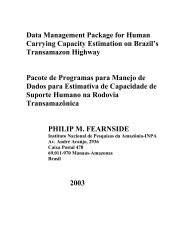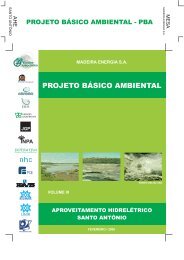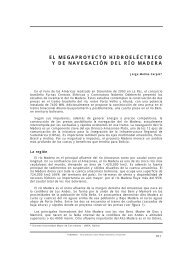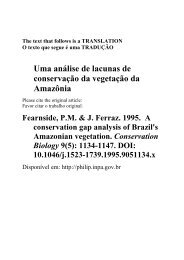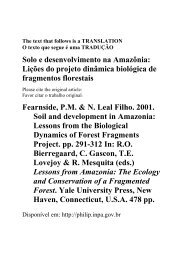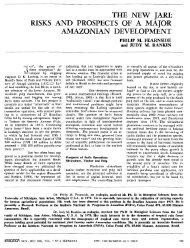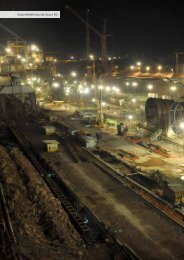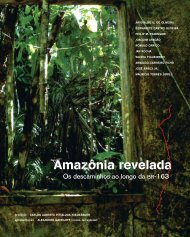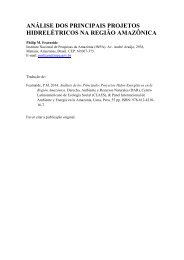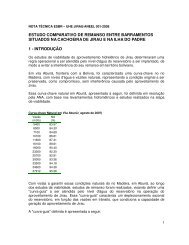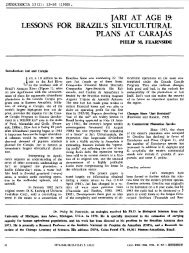THE FUTURE OF THE AMAZON - Philip M. Fearnside - Inpa
THE FUTURE OF THE AMAZON - Philip M. Fearnside - Inpa
THE FUTURE OF THE AMAZON - Philip M. Fearnside - Inpa
You also want an ePaper? Increase the reach of your titles
YUMPU automatically turns print PDFs into web optimized ePapers that Google loves.
7Changing Patterns of DeforestationThe spatial patterns of Amazonian forest conversion are changing in alarming ways.Historically, large-scale deforestation has been most intensive in the eastern andsouthern areas of the Amazon (the “arc of deforestation”), in the Brazilian states ofPará, Maranhão, Rondônia, Acre, and Mato Grosso, and in northern Bolivia (Skole andTucker 1993). Since the 1960s, forest conversion has risen dramatically in these areasas a result of large-scale ranching, logging, international development projects,government-sponsored colonization schemes, mining, hydroelectric dams, and landspeculation (<strong>Fearnside</strong> 1987, 1990, 1995, Dale and Pearson 1997, Nepstad et al. 1997,Steininger et al. 2001a, 2001b). There also has been considerable forest clearing alongrivers and in parts of the northern and western Amazon--in Ecuador, Colombia, Peru,and Roraima (Brazil).But this picture is rapidly changing. Major new highways, roads, andtransportation projects are now dissecting the heart of the basin, providing access toareas once considered too remote for development. One of the most ambitious newhighways, BR-174, runs from the city of Manaus in central Amazonia, northward to theVenezuelan border, spanning a distance of over 1,000 km. Almost fully graded andpaved, it was initially promoted as a surgical cut through the forest to provide directaccess to Caribbean ports and markets in Venezuela. In 1997, however, BrazilianPresident Fernando Henrique Cardoso announced that 6 million ha of land along thehighway would be opened to settlement, and boasted that the area to be farmed wouldbe "so colossal that it would double the nation's agricultural production” (de Cassia1997). This highway is already promoting rapid forest clearing, especially within 100 kmof Manaus.As a result of logging booms and rapidly increasing development, central andnorthern Amazonian cities such as Manaus, Santarém, and Boa Vista are burgeoning.Ongoing construction to link Manaus to Rondônia in southern Amazonia by pavinghighway BR-319 will provide greatly increased access to the region for migrant settlers,and raises the alarming prospect that over the next decade Amazonian forests could bebisected by an expanding swath of deforestation and logging (Laurance 1998).New Infrastructure ProjectsAmazonian countries have ambitious, near-term plans to develop major infrastructureprojects encompassing large expanses of the basin. These projects are intended toaccelerate economic development and exports, especially in the agriculture, timber, andmining sectors of the economy. In the Brazilian Amazon, massive investments, on theorder of $40 billion in the years 2000-2007, are being implemented to fast-trackconstruction of dozens of major infrastructure projects—highways, railroads, gas lines,hydroelectric projects, power lines, and river-channelization projects (Anon. 1999,Avança Brasil 1999). The Amazonian road network is being rapidly expanded andupgraded, with many unpaved sections being converted to paved, all-weatherhighways. Key environmental agencies, such as the Ministry of the Environment, arebeing largely excluded from the planning of these developments (Laurance and<strong>Fearnside</strong> 1999, Laurance et al. 2001b).One indicator of the scale of planned development is the rapidly expanding



